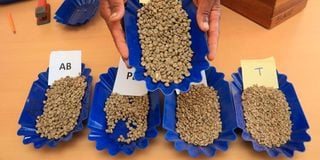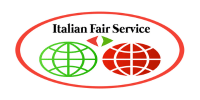
A Coffe grader displays various grades of green coffee beans at Kirinyaga County Cooperative Union Laboratory on February 26, 2019. MSMEs Cloud Revive Our Ailing Economy They Deserver More Support
Her customers were smallholder poultry farmers, mostly women, who got the feeds on credit.
The farmers sold their eggs to Jane who would then sell to retail markets at a profit, which allowed her to recover the cost of feeds and pay the farmers for their eggs.
Things were going well until Jane could no longer continue making feeds owing to the cost of inputs.
Once her factory went out of business, most of her customers could not continue with their poultry farming as they could not afford feeds from other suppliers.
And just like that, livelihoods were lost, and an entire agribusiness ecosystem disappeared.
Micro, Small and Medium Enterprises (MSMEs) such as Jane’s represent a significant part of the world economy, and are one of the strongest drivers of economic development, innovation and employment
“MSMEs play an instrumental role in the Kenyan economy, in creating employment and supporting livelihoods. It is estimated that the sector employs over 15 million people and contributes about 30% to the national value-added. Despite this, MSMEs continue to face substantial challenges, key among them limited access to finance that impedes their growth,” states a World Bank MSME Survey published in 2021.
One of the most persistent challenges for agribusinesses in emerging market countries such as Kenya is the difficulty they have accessing finance.
They do not meet market requirements to attract funding, often because they are not run like other businesses. They suffer from long investment cycles, long production cycles, and production volatility.
And financiers – who range from local financial institutions to regional and social lenders to social and global investors – find the agricultural sector too risky and expensive to service.
A specific category of agri-MSMEs have it worse. These are the underserved “missing middle’’ who nobody has created fitting financial solutions for.
They are usually too large to receive financing from microfinance institutions, but simultaneously too small for classic local commercial banks, development partners or impact investors.
Most need finance products ranging between Sh100,000 to Sh1 million to operate and grow.
Despite Kenya’s reputation as a leader in financial innovation, MSMEs confront a Sh2.2 trillion financing gap.
Why are current finance options failing to serve the missing middle in Kenya?
First, funders largely use traditional instruments for financing MSMEs that have worked well in the developed world, without looking at the needs of agri-MSMEs in developing contexts.
For example, equity investing works very well for angel investors and venture capital firms in Silicon Valley, but the structures required for successful equity investing which include legal frameworks, high growth potential and a clear exit strategy are not viable for many MSMEs in Kenya.
As in the rest of the world, MSMEs largely need simple growth and working capital in the form of debt, at good rates that they can easily access.
Second, most funders, including impact investors, are looking for MSMEs with somewhere between 10-30 per cent annual growth to manage the risk of investing in frontier markets as well as satisfy their return expectations.
Going by this criterion, only 13 per cent of MSMEs in Kenya would qualify for funding, mostly made up of high-growth tech start-ups or successful scalable businesses.
The majority, 45 per cent, are categorised as ‘low growth’, which are small businesses (5-19 employees) that generate modest growth and return but make a living for employees. With such a mismatch between expected returns and the reality of the market, it is clear how the missing middle persists.
While MSMEs may be less conventional investments, these businesses must be targeted to realise the broad-reaching economic benefits of their growth.
Blending finance between private and public sources spreads risk and several enterprises are using this to take on more risk.
But funders need to be more ambitious with reach and less with return if they are going to serve the missing middle successfully.
For example, many financial institutions still require hard collateral, specifically title deeds, as a requirement for their lending.
Use of alternative collateral such as crops, or livestock can substitute land so more MSMEs can access credit.
Other creative lending models that work well include Warehouse Receipt System (WRS) financing where MSMEs store their agricultural produce in registered warehouses and receive a receipt that they can use as alternative collateral to secure financing from financial institutions.
The produce is stored until such a time when it can fetch competitive prices earning the MSMEs a reasonable profit. The Warehouse Receipt System Act was developed in 2019 but most financial institutions are yet to fully embrace it.
Another option is the wholesale lending model where financial institutions lend to Savings and Cooperative Societies (SACCOs) that are regulated by the SACCO Society Regulatory Authority (SASRA) and Micro Finance Institutions (MFIs) that are regulated by Central Banks.
The SACCOs and MFIs have the required collateral that the financial institutions require. They in turn lend the funds to their member MSMEs.
A third option is the value chain finance model where a key player in the value chain, referred to as an anchor, is identified for funding by a financial institution.
The anchor can provide the required collateral and in return is able to offer credit either in cash or in kind to other MSMEs based on pre-existing relationships.
In most cases, the anchor has contracted the MSMEs and offtakes their produce once they are ready for market.
An example would be a fish processor who is financed by a financial institution, who then extends the credit to fish farmers who are his clients.
The credit can be in cash as working capital or in form of Inputs.
The farmers sell their produce to the processor who deducts the credit plus any other costs and pays the farmers the balance. This model is like the one that Jane had with the egg farmers.
Finally, more financial institutions should apply the risk-sharing facility and credit guarantee schemes that enables them to lend to MSMEs with a guarantee of protection.
The Government launched the Credit Guarantee Scheme in 2020 to catalyse funding to the agricultural sector but few financial institutions have subscribed to it.
Awareness creation around these products coupled with Increasing both the number/type of participating financial institutions as well as the exposure limit would encourage them to lend to MSMEs.
With a little creative thinking and goodwill, financial institutions could cultivate strong credit products for MSMEs thus expanding their customer base and ensuring the survival of critical entities in the country’s economy.
It’s a win-win situation. At the very least, it would keep entrepreneurs such as Jane in business and protect the livelihoods of countless households.

